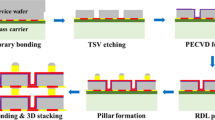Abstract
Polyimides have been considered as interlayer dielectrics for wafer scale integration (WSI) and wafer scale hybrid packaging (WSHP). However, high temperature curing steps for polyimide lead to large stresses in polyimide films. This is due to differing thermal expansion coefficients of the metal conductor, insulator and substrate materials causing yield and reliability problems. Polyimides also require the use of solvents, and tend to outgas during subsequent processing. They tend to absorb moisture with resulting degradation of dielectric constants. Also, the spin on method used to apply and planarize polyimide layers exhibits nonuniformity of thickness on large wafers. In this paper we examine parylene (Poly-p-xylylene) and some of its derivatives as possible interlayer dielectrics due to some of their attractive features. Parylene has a low dielectric constant. It can be vapor deposited at low temperatures and in vacuum. It is also highly resistant to corrosion and is a clear, transparent material with possible use for optical interconnections. This paper studies the reactive ion etching properties for polyimides and parylenes in an oxygen containing plasma under identical conditions. The etching rates of the parylenes and polyimides have been compared. The surface properties of these polymers are examined. Further, the film growth properties of aluminum deposited on the etched surfaces using the ionized cluster beam are investigated.
Similar content being viewed by others
References
J. F. McDonald, A. J. Steckl, C. A. Neugebauer, R. O. Carlson and A. S. Bergendahl, J. Vac. Sci. Tech. A 4, 3127 (1986).
K. L. Mittal, Ed., “Polyimides—Synthesis, Characterization, and Applications,“ Volumes I, II, Plenum Press, 1984.
R. Selvaraj, S. N. Yang, J. F. McDonald and T. M. Lu, “Ion Cluster Beam Metallized Interconnections of Wafer Scale Integration,“ Proc. VLSI 1987 Multilayer Interconnection Conf., V-MIC87, Santa Clara, CA, pp. 440–448, June 15–16, 1987.
N. Majid, S. Dabral, H. T. Lin and J. F. McDonald, “Parylene as an Interlayer Dielectric for Wafer Scale Interconnections,“ Proc. VLSI 1988 Multilayer Interconnection Conf., V-MIC88, Santa Clara, CA, pp. June 13–14, 1988.
W. F. Gorham, US Patent 3,342,754, Para-Xylylene Polymers, Sept. 1967.
W. F. Gorham and J. T. C. Yeh, J. Organic Chem. 34, 2366, (1965).
S. W. Chow, L. A. Pilato and W. L. Wheelwright, J. Organic Chem. 35, 20(1966).
B. L. Joesten, J. Appl. Polymer Sci. 18, 439 (1974).
B. J. Bachman, “Poly-p-Xylylene as a Dielectric Material,“ First International SAMPE Electronics Conf., pp. 431–440, June 23–35, 1987.
J. T. C. Yeh and K. R. Grebe, J. Vac. Sci. Tech. A 1 604 (1983).
D. L. Cho and H. Yasuda, “Adhesion, Barrier, and Passivation Characteristics of Plasma Polymerized Organic Thin Films,“ in “Surface and Colloid Science in Computer Technology,“ K. L. Mittal, Ed., pp. 249–265, Plenum Press, 1988.
N. J. Chou and C. H. Tang, “A Thermodynamic Model for Predicting Formation of Chemical Bonds between Metals and Cured Polyimides During Metallization,“ op. cit., pp. 287–298.
J. F. Evans, J. G. Newman and J. H. Gibson, “The Mechanism of Plasma Etching of Polymers and its Relevance to Adhesion,“ op. cit., pp. 299–308.
J. E. E. Baglin, “Radiation Enhanced Adhesion of Thin Films,“ op. cit., pp. 211–233.
Nulcear Scattering Profiles of Polyimide-Metal Interfaces, op. cit., pp. 267–285.
B. J. Bachman, and M. J. Vasile, “Ion Bombardment of Polyimide Films,“ Proc. 38-th Elec. Comp. Conf. (ECO, Los Angeles, CA, May 9–11, 1988, pp. 444–451.
NOVA TRAN/Union Carbide Technology Letter #13 “Solvent and Vapor Phase Adhesion Promotion Systems for Parylene,“ NOVA TRAN, Inc., 100 Deposition Drive, Clear Lake, WI 54005.
H. Yasuda, “Plasma Polymerization,“ Academic Press, 1985.
H. Dohmoto, F. Nakanishi, H. Usui, I. Yamada and T. Takagi, “Electrical Characteristics of Polyethylene Thin Films Deposited by the ICB Method,“ Proc. Int., Workshop on ICBT Tokyo-Kyoto, p. 171–176, 1986.
L. B. Rothman, J. Electrochem. Soc. 130, 1131 (1983).
NOVA TRAN, INC., “Parylene Pellicles for Space Applications,“ Publication by NOVATRAN, 100 Deposition Drive, Clear Lake, WI 54005.
M. A. Spivack, Rev. Sci. Instrum. 41, 1614 (1970).
H. Usui, I. Yamada, and T. Takagi, “Anthracene and Polyethylene Thin Film Depositions by Ionized Cluster Beam,“ J. Vac. Sci. Technol., A, Vol. 4, No. 1, pp. 52–60, Jan/Feb (1986).
Author information
Authors and Affiliations
Rights and permissions
About this article
Cite this article
Majid, N., Dabral, S. & McDonald, J.F. The parylene-aluminum multilayer interconnection system for wafer scale integration and wafer scale hybrid packaging. J. Electron. Mater. 18, 301–311 (1989). https://doi.org/10.1007/BF02657422
Received:
Revised:
Issue Date:
DOI: https://doi.org/10.1007/BF02657422




